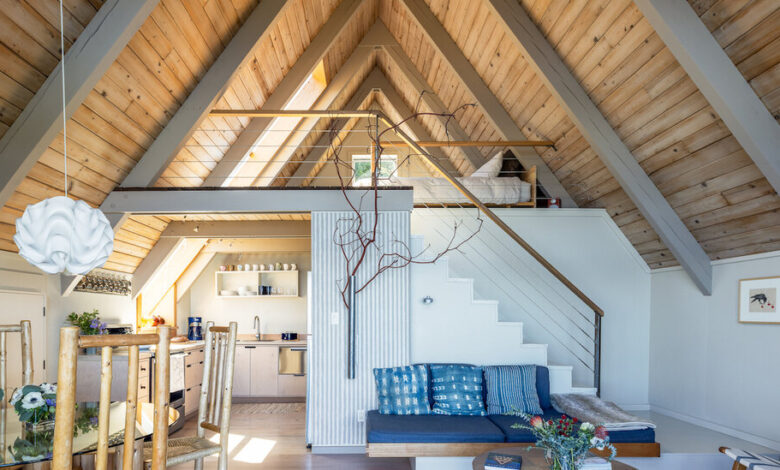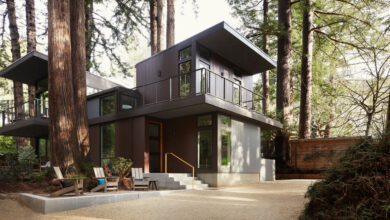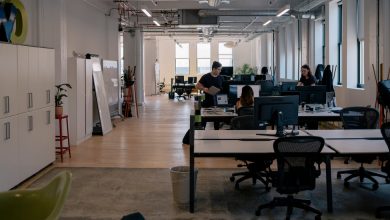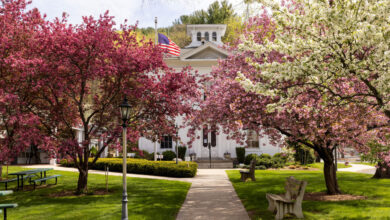They Turned a Tiny Cabin in Coastal Washington Into Their Island Escape

For an escape in the San Juan Islands, a little more than two hours north of Seattle, Joe Herrin knew he wouldn’t need much.
Growing up, the highlight of every summer was a two-week boat trip around those islands near the Canadian border, where his family slept within the confines of a 26-foot-long boat hull. Later, as a young adult, he assumed he would have a boat of his own.
But shortly after he met his future wife, Belinda Bail, he took her to see Orcas Island — the largest of those islands in northwestern Washington — by way of ferry and car. “And I discovered there’s a whole lot more to the islands than what you can see from the shoreline,” said Mr. Herrin, 57, a founding principal of Heliotrope Architects.
“He took me to his favorite place, and I fell in love with it too,” said Ms. Bail, 56, an architect who works for the real estate investment company BentallGreenOak. “I’ll just never forget driving across Orcas Island the first time, past this huge state park, Moran State Park, and along this pretty little lake, Cascade Lake. It was a really magical place.”
In the years that followed, the couple married and bought a house in Seattle that had belonged to Mr. Herrin’s grandparents, doing piecemeal renovations as their finances allowed. By early 2002, they were expecting their first daughter, Audrey, now 21.
That’s when Mr. Herrin suddenly felt compelled to find a vacation home in the islands.
“It was financially stupid,” he said, as he and Ms. Bail were already stretched by the Seattle renovation and had little in savings. “But I just wanted to give my kids something like what I had growing up.”
With a loan from Ms. Bail’s parents, they began looking for the least expensive home they could buy on Orcas Island. What they found was a 1960s A-frame built from a kit that was part of a condominium association, providing nine owners with 50 feet of waterfront each, across 36 shared acres. The cabin measured about 825 square feet, including an open sleeping loft. And it was gradually sinking into the earth, because it had no foundation.
The asking price was $350,000. The couple offered $275,000, the most they could afford. They received no response. The cabin was still on the market in the fall of 2002, so they made the same offer again — and this time, the seller accepted.
Over the next two decades, they worked to improve it. The first big project: putting a foundation under the cabin and replacing the single-paned windows with double-paned ones.
“We had to refinance our house to pull out enough money to put a foundation under it,” Mr. Herrin said. “After the contractor was finished, we had spent every penny we had, so the only way to make more progress was to do it ourselves.”
So the couple began holding regular “work parties” — weekends with friends where they supplied shelter, food, beer and wine in exchange for free labor. They built a new deck; tore out the shag carpeting and put down pine flooring; painted the wood beams inside; bleached the paneling; and planted a garden.
“It was a blast,” Mr. Herrin said. “People loved it.”
Along the way, they welcomed a second daughter, Marina, now 13. And as their finances improved, they began hiring contractors to tackle larger jobs.
They removed the old roof to install better insulation, and then added a metal roof. They cut in a tall skylight that rises from the kitchen to the sleeping loft. They added a built-in bed with integrated storage drawers in the sleeping loft and a built-in sofa at the bottom of the stairs to maximize space in the living room.
Most recently, they expanded (slightly) with a tiny addition to the back of the house. Measuring 48 square feet, it provides a proper entrance and a more comfortable shower. They clad this section in cedar siding that their contractor milled from a log he found floating in the water. At the same time, they renovated the kitchen with simple birch-plywood cabinetry and laminate counters.
The total cost of improvements before the addition was only about $70,000, Mr. Herrin said, because they did so much of the work themselves. The addition and kitchen renovation, which were completed in 2021, cost an additional $100,000.
But even after all the work, “what we love about it the most is the simplicity,” Ms. Bail said, noting that they never aspired to create anything more than a functional cabin on the beach.
“It’s the place that’s permanent for our family,” she added. “We might move around and change houses in the city. But the cabin is the special place for our family, where we’ll always go back to spend quality time together and share memories, friends, family and food.”
Living Small is a biweekly column exploring what it takes to lead a simpler, more sustainable or more compact life.
For weekly email updates on residential real estate news, sign up here.
Source link





